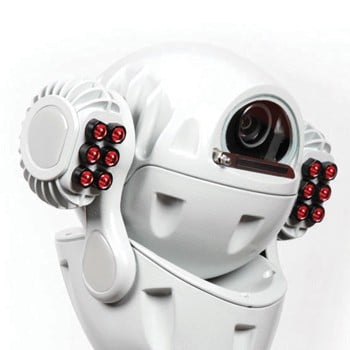Nightvision CCTV Cameras
Posted on Wednesday 21st September 2016There are many different options for seeing in the dark, some often overlooked. In this news article we'll explore the advantages and disadvantages of each option, and which one best suits a particular situation.
Infra-red
This is the most common one, it's useful in all sorts of applications and relatively cheap. As well as being covert and low power.
What is infra-red CCTV?
Infra-red is a type of light with a longer wavelength than that of the visible spectrum which we use to see, meaning we can't see the light emitted. However, specific IR (infrared) sensitive CCTV cameras can. To the end user this means that while it may be pitch-black in your warehouse, using your CCTV system you'll be able to clearly see what's happening. But remember, that while during daylight hours IR cameras work just like a normal camera, seeing in colour, when it gets dark and they have to rely on their IR lights to see, they will automatically switch to black and white.
Types of infrared
Bulbs
A few years ago most IR lights used standard halogen bulbs, with a bandpass filter placed in front. This bandpass filter would only let the IR light through, reflecting the rest back into the housing. This caused them to get hotter than normal lights, so the bulbs wouldn't last as long meaning more maintenance call-outs.
LED's
These day's LED's (light emitting diodes) are used. They run cool, and have thousands of hours of life. The LED technology is always advancing, with the latest technology lights being capable of illuminated distances over 150 meters!
Covert
The wavelength of infrared light is right next to the colour red, and there can be some bleed over, this is why when looking at an infrared light you'll often see a dull red glow being emitted. This usually isn't a problem, but in cases where you need a completely covert option you can go for the 940nm (measurement of wavelength) option, which, while it isn't quite as powerful as the standard 850nm lighting, emits zero red light.
Built-in
 One of the most common methods is to build the IR LEDs into the camera housing, this is very handy as the light is always pointing where it's needed - in the cameras field of view. They can even be built into PTZ (pan, tilt, zoom) moving cameras.
One of the most common methods is to build the IR LEDs into the camera housing, this is very handy as the light is always pointing where it's needed - in the cameras field of view. They can even be built into PTZ (pan, tilt, zoom) moving cameras.
Why choose infrared?
Infrared is one of the most popular options when choosing a night vision system, but why is this?
- Cost - Infrared is one of the cheapest ways of seeing in the dark, mainly due to advancement in LED technology, and the fact it is so popular.
- Covert - IR light is invisible, meaning you can illuminate large areas without causing light population, and without deterring would-be intruders (whether this is a good thing or not is up to you!)
- Flexible - Depending on the range needed IR light can be tiny, this allows them to be fitted almost anywhere, even into tiny covert cameras.
Spiders!
The bane of many a security installer spiders like nothing more than to build their home on a nice and warm CCTV camera. Ask what can be done about the useful, but sometimes annoying creatures!
Thermal
Up until very recently thermal imaging was a very expensive option, it can still be costly but in the right circumstances can be invaluable.
What is Thermal CCTV?
As the name suggests, thermal CCTV doesn't use light to pick up an image, instead it detects heat. You've probably seen them at use on Police, Camera, Action or similar. They have a huge range, and are being used on an increasingly large number of sites.
Check out this video to see a thermal camera in action. This particular video is made by a very popular and high quality camera manufacturer and features an IP camera.
The benefits of thermal
Thermal imaging cameras detect the heat energy emitted by people and objects and use this to create an image. As this requires no illumination there are no shadows to hide in, and human intruders can be detected at distances of up to 30km!
White light
Using white light (normal, visible light) is often overlooked, but it does have its uses and some cameras are even coming out with built-in LED's using white light.
The benefits of white light
White light is an excellent detterent, keeping would be intruders away, as well as another advantage, which is colour. Unlike IR illumination, white light is just like daylight, giving you sometimes vital information about the intruders clothing and vehicle. Some cameras even have a built in motion sensor, turning on the ultra bright LED's when movement is detected.
So there we have it
Those are the options available to you when trying to see in the dark. If you have any questions or queries, feel free to give us a call on 01743 884765, or click here to visit our contact us page.

